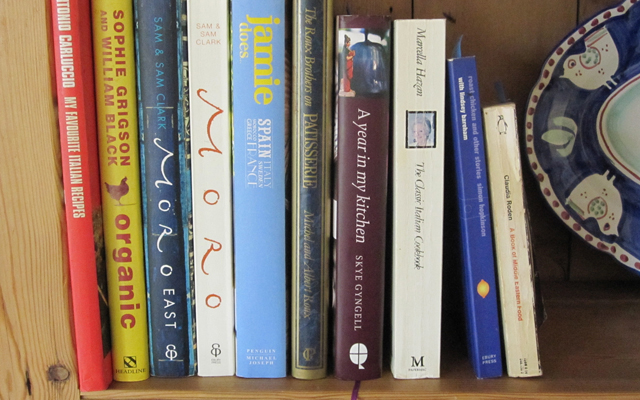This year’s best cookbooks
We list our favourite cookery books published this year.

Each year, publishers try to think of new types of cookery books. This year, Quadrille has won with Salad Love by David Bez (£16.99 *£15.29). Mr Bez is not a chef, not even a cook, but a designer who took to making daily salad lunches at his office desk and then photographing them. He had a drawer full of kitchen tools and the office windowsill was filled with pots of herbs. As a designer and an Italian, he has made a truly beautiful and inspiring book. The colourful salads are all photographed on plain white plates; office life will never be the same.
The Buenvino Cookbook (Jeannie and Sam Chesterton, Bene Factum Publishing, £20 *£18) is another real-life cookery book, subtitled Recipes from our Farmhouse in Spain. The authors run cookery courses in Andalusia that are clearly totally uncheffy as is the book. If you’re a tapas freak like me, this is one for you.
One of the strands to come out in cookery this season is a combination of growing and eating. A Year at Otter Farm by Mark Diacono (Bloomsbury Publishing, £25 *£22) adds growing vegetables and keeping hens to relevant recipes, arr-anged seasonally. Many dishes work, even if you don’t have a vegetable plot, although, ideally, you should. Beautiful photographs by the author.
Carina Contini’s Kitchen Garden Cookbook (Frances Lincoln, £25 *£20) is by one of the famous Contini family, which runs Edinburgh’s best deli, Valvona & Crolla, as well as restaurants in the city. The book describes setting up a kitchen garden to supply the restaurants and how the produce is used. The subtitle, A Year of Italian Scots Recipes, refers to a surprising union that works well.
The mixture of chef and head gardener is also celebrated in Kitchen Garden Experts (Frances Lincoln, £20 *£18), with, in this case, more emphasis on the garden. Chefs and other foodies include Sir Terence Conran, Simon Rogan of L’Enclume, herbal expert Jekka McVicar, Skye Gyngell and Raymond Blanc, whose Le Manoir aux Quat’Saisons has a deserved reputation for its vegetables. Extremely helpful, with tasty varieties and tips on growing.
The Edible Atlas by Mina Holland (Canongate Books, £18.99 *£17.09) is another bright idea. The author writes of food habits, spice mixtures and recipes from around the world, although British cuisine is ignored. This debut is as much a book to read as one to cook from. The dust jacket unfolds into a poster.
Dorling Kindersley’s (DK) Mediterranean Cookbook, edited by Marie-Pierre Moine (£20 *£18), is a family Bible-sized volume that, like many of DK’s, is as helpful on ingredients as recipes. Contributing authors are Elisabeth Luard and Ghillie Basan.
Exquisite houses, the beauty of Nature, and how to get the most from your life, straight to your inbox.
DK has also published The Meat Cookbook by Nichola Fletcher (£25 *£22.50), similar in size and content and with recipes by Christopher Trotter, Elena Rosemond-Hoerr and Rachel Green. But buy this for information on meat: Mrs Fletcher knows her stuff, having run a venison farm in Scotland for more than 30 years (and having been awarded an MBE for it).
Other books concentrate on single ingredients: Charcuterie by Miranda Ballard (Ryland Peters & Small (RPS), £16.99 *£14.99) makes one race to the deli counter; Vanilla by Janet Sawyer (RPS, £16.99 *£15.29) shows how the denigrating term ‘plain vanilla’ is plain wrong. Just try venison with chocolate and vanilla or scallops with vanilla risotto to see the uses of the little pod.
Chocolate at Home by Will Torrent (RPS, £19.99 *£17.99) is a complete guide, including equipment, origins and varieties. It’s clearly a messy business, although the photographs only hint at this. Ingredients include crystallised thyme leaves, chillies and freeze-dried rose petals and recipes are for chocolate pizza, chocolate tea and double-pepper-mint snap. An excellent present.
Ursula Ferrigno explains how olives grow and why homemade vinegars need a mother in A Gourmet Guide to Oil and Vinegar (RPS, £19.99 *£17.99).
Now, a quick rundown of the chefs’ publications this season: Yotam Ottolenghi’s Plenty More (Ebury Press, £27 *£24) is as inspiring as always. Indeed, The Spectator says this book is ‘a vision of contemporary Britain’, where za’atar has replaced Worcestershire Sauce and pomegranate molasses is the new mustard. The chef concentrates on vegetables, dividing the book into cooking techniques, such as tossing, steaming and mashing. Smashing.
Hugh Fearnley-Whittingstall writes along similar lines in Light & Easy (Bloomsbury Publishing, £25 *£22.50), with recipes for quick, healthy food. I’ll certainly use this one often. I’ve already used Antonio Carluccio’s Pasta (Quadrille Publishing, £20 *£16), with his delicious roast-pepper-and-anchovy sauce; he’s managed to reinvigorate what seemed a tired old subject.
I’d buy Gerhard Jenne’s Konditor & Cook: Deservedly Legendary Baking (Ebury Press, £20 *£18) for the fun he has with cakes: cupcakes topped with menacing spiders, a chocolate cake pretending to be a cabbage (the idea of Priscilla Carluccio) and a halloween gravestone lettered ‘RIP Diet’. All Things Sweet (Harper-Collins, £25 *£20) comes from Rachel Allen of the Ballymaloe cooking dynasty. The recipes certainly deserve ‘RIP Diet’ over them, but are charming and unpretentious a characteristic of the famous cookery school.
Historic Heston (Blooms-bury Publishing, £40 *£36) is notable for its photography by Romas Foord, reminiscent of the most sumptuous Dutch still-life paintings, and for its dip into the history of British food, from rice and flesh (1390) to mock-turtle soup (1892), via powdered duck (1670) and hash of snails (1723). Recipes for all are given, but you’d need to be courageous (or mad) to tackle any of them. A book for the banqueting table instead.

-
 A flat for sale in the building where Agatha Christie lived, and it's both the most interesting and most affordable home for sale in Hampstead today
A flat for sale in the building where Agatha Christie lived, and it's both the most interesting and most affordable home for sale in Hampstead todayThe Isokon Lawn Road flats in Belsize Park are a Grade I-listed architectural icon with a fascinating history, and one of them is currently for sale. Toby Keel takes a look.
-
 Guinness, The Beatles and Beckham's first game for England? It can only be the Country Life Quiz of the Day, October 15, 2025
Guinness, The Beatles and Beckham's first game for England? It can only be the Country Life Quiz of the Day, October 15, 2025Test your general knowledge in Wednesday's quiz.